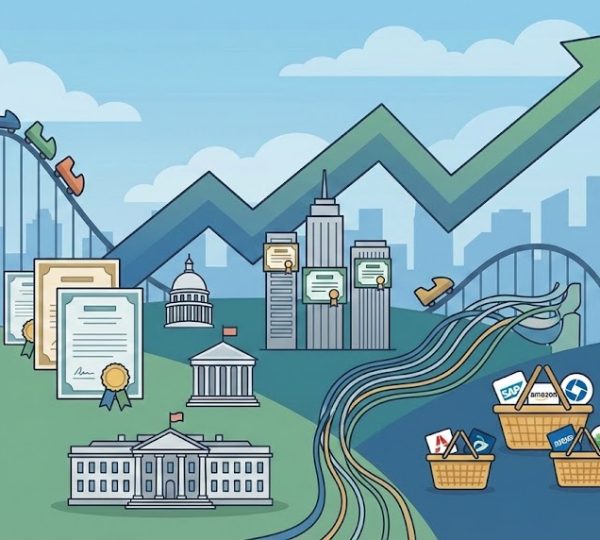Banking systems in a country play a vital role in any country’s financial system and economic infrastructure. Being one of the key determinants and distributors of credit, promotion of economic growth and balancing out monetary policy and inflationary trends in a country, the banking systems are highly recognized in the economic infrastructure.
The banking system that prevails in the United States is highly sophisticated in a technological sense and is diverse in the functionality and in the services they offer to the public.
This article will bring to you the key aspects, services and functions of the Banking system that exists in the USA.

Structural Analysis of the banking system in the USA
Much like any banking system in the world, the States also have a banking system comprising various sectors. These include credit unions, investment banking units, commercial banks, savings banks and much more. These various sectors collectively make up the entirety of the bank in question and provide a range of financial services and products under each relevant banking service.
Savings banks are the kind of banks that are responsible for the provision of mortgage loans and such. These banks also accept deposits, thus the name, and also these banks are usually for domestic use. Investment banking systems are for a much broader and larger financial customer base. This includes medium or large-scale businesses engaging in mergers, business dealings, foreign accounts, and acquisitions. These investment banks are facilitated with personnel and financial capacity and knowledge to assist in such large-scale efforts…
The most common kind of banking is the Commercial Banking system. Commercial banking systems are the key product of any typical banking system. They primarily provide banking services for both individuals and businesses and their various banking requirements. These banks fully accept deposits and offer loan schemes including housing loans, vehicle leases, and educational loans as a start. These are the banks that are primarily used by individuals and even small businesses for their financial activities.
Services and the customer-centric approach.
The United States banking system and the entire banking sector has been designed in a customer-centric model where the customer and his ease of access and transaction are taken into account. These systems offer convenience, accessibility and digitalized and innovative approaches to finding the best financial solutions.
The United States banking system offers an array of various services created to meet the specific needs of its client bases. The services provided by these systems include savings accounts, credit facilities, personal and business loans, mortgage solutions, credit and debit card facilities, investment services and advice on financial matters. Further, the ability to handle all the banking functions through the internet and inhouse designed mobile applications the ease of access to your account details and such have never been more convenient. Although the customary ATM and teller machine services also continue to exist at banks around the country, the digitalized banking system has proven to be of utmost help.
Function of regulating
The United States banking system functions in order to regulate and maintain the stability of the economy and financial markets. A banking system is important for a country’s monetary policy and this banking system functions at its best to prevent any financial crisis. The main regulatory bodies of the United States banking systems include the Federal Reserves System more commonly referred to as the Central Bank Office of the Comptroller of the Currency (OCC), the Federal Deposit Insurance Corporation (FDIC), and the Consumer Financial Protection Bureau (CFPB). The regulations imposed by these officers of the Government oversee the various and all activities and functions of the banking system of the United States and ensure that the system functions smoothly while leaving space for economic growth.
The institutions mentioned above which function under the banking systems of the United States, ensure that all risk management factors regarding the financial sector are handled, money laundering activities are mitigated, ensuring consumer protection and all financial laws are adhered to by the various individuals who attempt to receive banking services through the banks in the banking system.
Integration of technology
The advancement of technology in all fields has become a significant transformative factor. The online digital banking landscape that has been created in the United States has been deemed to be helpful to many individuals. The online, mobile banking platforms and the various mobile applications have all made banking easier to use and quicker to access. Customers, with this new technological advancement, have been able to monitor their finances conveniently over these mobile applications, make payments, settle loan payments, pay utility bills, receive payments and much more through these banking systems. Although all technological advancement also comes with the heavy price of data theft and internet hacking, this new and improved method of banking at the tips of one’s fingers is truly a hallmark of the United States banking industry.
The integration of technology into this age-old system of banking has also raised many concerns, especially among senior citizens, who find it difficult to use mobile phones and even navigate these apps as they appear complex to them. Plus their use of traditional banking systems has been demolished by the forceful integration of technology into some areas, which are utterly inconvenient for the elderly. However, the traditional systems do still function.
The United States banking system is a gold mine. Coming from one of the world’s strongest economies, it is vital to understand the complexity of its nature and try to divulge its functions to better understand the reasons for its success.



